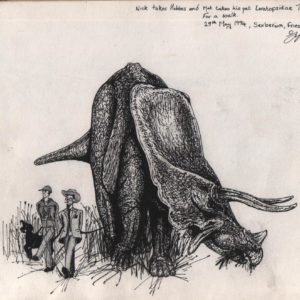
Je Suis Parasaurolophus
Je Suis Parasaurolophus (1m x 1m)
Dinosaurs are available at all scales, bespoke to your room.
Parasaurolophus meaning “near crested lizard” in reference to Saurolophus, is a genus of ornithopod dinosaur that lived in what is now North America during the Late Cretaceous Period, about 76.5–73 million years ago. It was a herbivore that walked both as a biped and a quadruped. Three species are recognized: P. walkeri (the type species), P. tubicen, and the short-crested P. cyrtocristatus. Remains are known from Alberta (Canada), and New Mexico and Utah (USA). The genus was first described in 1922 by William Parks from a skull and partial skeleton found in Alberta.
Parasaurolophus was a hadrosaurid, part of a diverse family of Cretaceous dinosaurs known for their range of bizarre head adornments. This genus is known for its large, elaborate cranial crest, which at its largest forms a long curved tube projecting upwards and back from the skull. Charonosaurus from China, which may have been its closest relative, had a similar skull and potentially a similar crest. Visual recognition of both species and sex, acoustic resonance, and thermoregulation have been proposed as functional explanations for the crest. It is one of the rarer hadrosaurids, known from only a handful of good specimens.

Walking With Triceratops
Walking With Triceratops
A favourite pencil, pen and ink drawing of Nick, walking his dog and Matthew, walking his Triceratops. 19cm x 14cm (image size). 31cm x 26cm (framed size).
The dinosaur belongs to a genus of herbivorous ceratopsid dinosaur that first appeared during the late Maastrichtian stage of the late Cretaceous period, about 68 million years ago (mya) in what is now North America. It is one of the last known non- avian dinosaur genera, and became extinct in the Cretaceous–Paleogene extinction.
The dinosaur’s name, which literally means “three-horned face”, is derived from the Greek τρί- (tri-) meaning “three”, κέρας (kéras) meaning “horn”, and ὤψ (ops) meaning “face”. It has been documented by numerous remains collected since the genus was first described in 1889, including at least one complete individual skeleton. Paleontologist John Scannella observed: “It is hard to walk out into the Hell Creek Formation and not stumble upon a Triceratops weathering out of a hillside.” Forty-seven complete or partial skulls were discovered in just that area from 2000 to 2010. Specimens representing life stages from hatchling to adult have been found. As the archetypal ceratopsid, Triceratops is one of the most popular dinosaurs, and has been featured in film, postal stamps, and many other types of media.